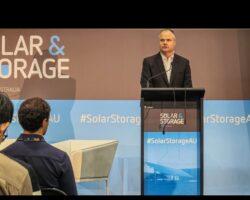US government scientists say they’ve vaulted a critical nuclear power threshold, achieving a net energy gain in a fusion reaction for the first time. The Department of Energy plans to announce the breakthrough on Tuesday, according to the Washington Post.
A fusion energy gain factor, usually expressed with the symbol Q, is the ratio of power produced in a nuclear fusion reactor to the power required to maintain the plasma in a steady state.
Typically, a fusion reaction that produces more power than it requires has evaded scientists, which is why modern nuclear power stations play host to nuclear fission reactions.
The difference between fission and fusion is what happens to the atoms during the reaction process. In a fission reaction, an atom is split into two or more smaller atoms, while during fusion, two or more smaller atoms are fused into a larger atom.
The amount of energy produced by a fusion reaction is several orders of magnitude larger than that produced by fission. It’s a series of fusion reactions that powers our sun.
This high power production, as well as the relatively tiny amount of long-term radioactive waste produced, makes fusion an attractive prospect. According to the Financial Times, a small cup of hydrogen fuel could theoretically power a house for hundreds of years.
A major breakthrough, but…
That’s why the news is a major breakthrough, though it’s still early days.
The news was first confirmed to the FT on Sunday by three people close to the experiment, which was demonstrated at the Lawrence Livermore National Laboratory’s National Ignition Facility in California.
The laboratory there uses a process called inertial confinement fusion, which involves bombarding a tiny pellet of hydrogen plasma with the world’s biggest laser.
But experts caution that this no doubt major result is still a far cry from a workable fusion reactor.
Professor Justin Wark, professor of physics at the University of Oxford and director of the Oxford Centre for High Energy Density Science, says the result is a major breakthrough in fusion science, but more progress is needed.
“First we need to get much more out that is put in so to account for losses in generating the laser light, etc… Secondly, the Lawrence Livermore National Laboratory could in principle produce this sort of result about once a day – a fusion power plant would need to do it ten times per second,” Wark said.
“However, the important takeaway point is that the basic science is now clearly well understood, and this should spur further investment.”
Tony Roulstone, a lecturer in nuclear energy at the University of Cambridge, says that while it’s positive news, the LLNL result is still a long way from the actual energy gain required for the production of electricity.
“That’s because they had to use 500 MJ of energy into the lasers to deliver 1.8 MJ to the target – so even though they got 2.5 MJ out, it’s still far less than the energy they needed for the lasers in the first place,” he said.
“In other words, the energy output (largely heat energy) was still only 0.5% of the input.
“An engineering target for fusion would be to recover much of the energy used in the process and get an energy gain of double the energy that went into the lasers – it needs to be double because the heat must be converted to electricity and you lose energy that way.”
Professor Justin Wark, the Professor of Physics at the University of Oxford and Director of the Oxford Centre for High Energy Density Science, said while the laboratory can now – in principle – produce this sort of result about once a day – a fusion power plant would need to do it ten times per second.
“However, the important takeaway point is that the basic science is now clearly well understood, and this should spur further investment. ”
“










